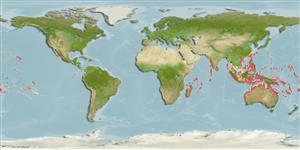Common names from other countries
Environment: milieu / climate zone / depth range / distribution range
экология
морской ассоциированный с рифами; пределы глубины 1 - 25 m (Ref. 90102). Tropical; 28°N - 32°S
Indo-West Pacific: Mauritius to Fiji, north to the Ryukyu Islands, south to Western Australia and the Great Barrier Reef. Recently recorded from Tonga (Ref. 53797).
Size / Вес / Возраст
Maturity: Lm ? range ? - ? cm
Max length : 31.0 cm TL самец/пол неопределен; (Ref. 9710)
колючие лучи спинного плавника (общее число) : 9; членистые (мягкие) лучи спинного плавника (общее число) : 11 - 13; колючие лучи анального плавника: 3; членистые (мягкие) лучи анального плавника: 11 - 13. Color of Philippine `pterophthalmus' form very dark olive-brown; scales with reddish margins; body without markings. Male form (painting) reddish brown, each scale with a vertical blue line; irregular blue lines on head and thorax; median fins with spots or stripes and colored margins. Dorsal spines pungent. Caudal fin rounded in juveniles. Juveniles with large ocelli at the ends of the dorsal and anal fins (Ref. 48636).
Adults inhabit shallow coral reefs, often in weedy areas (Ref. 9710). Feed on benthic invertebrates. Expatriate juveniles are transported by currents to subtropical zones during pelagic stages (Ref. 48636). Oviparous, distinct pairing during breeding (Ref. 205). Occasionally seen in fish markets or aquarium trade.
Life cycle and mating behavior
Maturities | размножение | Spawnings | Egg(s) | Fecundities | личинки
Pelagic spawner (Ref. 32193). Oviparous, distinct pairing during breeding (Ref. 205). Protogyny was proposed but not confirmed (Ref. 103751).
Westneat, M.W., 2001. Labridae. Wrasses, hogfishes, razorfishes, corises, tuskfishes. p. 3381-3467. In K.E. Carpenter and V. Niem (eds.) FAO species identification guide for fishery purposes. The living marine resources of the Western Central Pacific. Vol. 6. Bony fishes part 4 (Labridae to Latimeriidae), estuarine crocodiles. FAO, Rome. (Ref. 9823)
Статус Красного Списка МСОП (Ref. 130435)
CITES (Ref. 128078)
Not Evaluated
Угроза для людей
Harmless
Использование человеком
рыболовство: не имеет хозяйственного значения; аквариум: коммерческий
дополнительная информация
инструменты
Специальные отчеты
Скачать в формате XML
ресурсы в Интернет
Estimates based on models
Preferred temperature (Ref.
115969): 24.6 - 29.3, mean 28.3 (based on 2750 cells).
Phylogenetic diversity index (Ref.
82804): PD
50 = 0.5002 [Uniqueness, from 0.5 = low to 2.0 = high].
Bayesian length-weight: a=0.00977 (0.00470 - 0.02030), b=3.07 (2.89 - 3.25), in cm Total Length, based on LWR estimates for this (Sub)family-body shape (Ref.
93245).
Trophic level (Ref.
69278): 3.5 ±0.50 se; based on food items.
устойчивость к внешним воздействиям (Ref.
120179): средний (среднего размера), минимальное время удвоения популяции 1.4-4.4 года (Preliminary K or Fecundity.).
Fishing Vulnerability (Ref.
59153): Low vulnerability (21 of 100).
